
Students learn a bit about cities in Germany and the differences between U.S. and German cities. Students learn about German cuisine.
- Subject:
- Languages
- Material Type:
- Activity/Lab
- Author:
- Shawn Moak
- Mimi Fahnstrom
- Amber Hoye
- Date Added:
- 04/20/2022

Students learn a bit about cities in Germany and the differences between U.S. and German cities. Students learn about German cuisine.
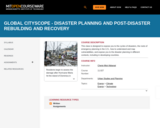
This class is designed to expose you to the cycles of disasters, the roots of emergency planning in the U.S., how to understand and map vulnerabilities, and expose you to the disaster planning in different contexts, including in developing countries.

This class is designed to expose you to the cycles of disasters, the roots of emergency planning in the U.S., how to understand and map vulnerabilities, and expose you to the disaster planning in different contexts, including in developing countries.
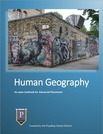
Human Geography: An open textbook for Advanced Placement is aligned to the 2015 College Board course articulation for AP Human Geography. The purpose of AP Human Geography is to introduce students to the systematic study of patterns and processes that have shaped human understanding, use, and alteration of Earth's surface. Students employ spatial concepts and landscape analysis to examine human social organization and its environmental consequences. They also learn about the methods and tools geographers use in their science and practice.

Kevin Lynch’s landmark volume, The Image of the City (1960), emphasized the perceptual characteristics of the urban environment, stressing the ways that individuals mentally organize their own sensory experience of cities. Increasingly, however, city imaging is supplemented and constructed by exposure to visual media, rather than by direct sense experience of urban realms. City images are not static, but subject to constant revision and manipulation by a variety of media-savvy individuals and institutions. In recent years, urban designers (and others) have used the idea of city image proactively – seeking innovative ways to alter perceptions of urban, suburban, and regional areas. City imaging, in this sense, is the process of constructing visually-based narratives about the potential of places.

This course introduces students to a set of analytic tools and conceptual frameworks through which to assess the origins and evolution of the institutions that constitute modern capitalism. The course takes an inter-disciplinary political economy approach that draws insights from economics, sociology, political science, history, geography, science and technology studies, and law.

This course examines both the structure of cities and the ways they can be changed. It introduces graduate students to theories about how cities are formed, and the practice of urban design and development, using U.S. and international examples. The course is organized into two parts: Part 1 analyzes the forces which act to shape and to change cities; Part 2 surveys key models of physical form and social intervention that have been deployed to resolve competing forces acting on the city. This course includes models of urban analysis, contemporary theories of urban design, and implementation strategies. Lectures in this course are supplemented by discussion periods, student work, and field trips.

This course examines the evolving structure of cities and the way that cities, suburbs, and metropolitan areas can be designed and developed. Boston and other American cities are studied to see how physical, social, political and economic forces interact to shape and reshape cities over time.

This course is a global-oriented survey of the history of architecture, from the prehistoric to the sixteenth century. It treats buildings and environments, including cities, in the context of the cultural and civilizational history. It offers an introduction to design principles and analysis. Being global, it aims to give the student perspective on the larger pushes and pulls that influence architecture and its meanings, whether these be economic, political, religious or climatic.

This course provides an introduction to public policy analysis. It is designed for students who may be planning a career in public or non-profit sectors. The primary goal is to help students understand the implications of public policy for different pursuits. The class examines various approaches to policy analysis by considering the concepts, tools, and methods used in economics, political science, and other disciplines. Students apply and critique these approaches through case studies of current public policy problems.

The course draws on faculty members from the Center for Real Estate, the City Design and Development Group (Department of Urban Studies and Planning), and the Media Lab to explore extraordinary projects that challenge conventional approaches to real estate development, urban design, and advanced digital technology.

This customized independent study course puts Sloan Fellows MBA students into direct contact with innovators tackling global needs in education, healthcare, and energy/environment. Co-designed projects address low-income markets in the U.S. or globally, focusing on the application of new ideas and technology rooted in MIT innovations or the Boston ecosystem. Every project aims to develop better ways for the right innovations to reach scale, sustainability, and quality, thereby improving lives and uncovering opportunities in underserved markets.
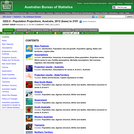
The population projections presented in this publication cover the period 30 June 2008 to 2101 for Australia and 30 June 2008 to 2056 for the states, territories, and capital cities/balances of state.
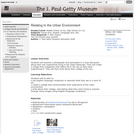
Students will examine a photograph and participate in a class discussion about their own experiences living in the urban landscape. They will create a collage from magazines that reflect life in the city as they have experienced it. They will then write about their collage of the city.

This course uses readings and discussions to focus on a series of short-term events that shed light on American politics, culture, and social organization. It emphasizes finding ways to make sense of these complicated, highly traumatic events, and on using them to understand larger processes of change in American history. The class also gives students experience with primary documentation research through a term paper assignment.
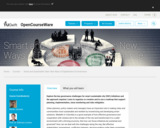
Explore the key governance challenges for smart sustainable city (SSC) initiatives and the approach required. Learn to organize co-creation and to use a roadmap that support planning, implementation, close monitoring and risks mitigation.
Urban planners, policy makers and managers have an important role in making cities and communities more sustainable and resilient by incentivizing and developing smart solutions. Medellín in Colombia is a good example of how effective governance and cooperation with citizens led to the remake of the city and transformed it to a safer environment with a thriving economy. But how can those initiatives be sustained and governed? How can we deal with the challenges along the way, like effective stakeholders’ engagement, conflicting interests, decision-making under deep uncertainty, interdependent problems, spatial justice, and the transformation towards a digital society? To sum it up: building smart sustainable cities initiatives requires a strong governance capacity and new approaches!
This course will:
- provide the principles for incentivising, planning, developing and managing sustainable smart city initiatives
- present an overview of the drivers and barriers for SSC development
- present sustainability challenges and tools for SSC development
- show practical recommendations to strengthen SSC governance capacity
- introduce a smart city governance roadmap
- explain the conditions for effective stakeholder engagement and ways to organize co-creation pathways
- clarify the regulatory and legal framework for SSC including privacy and cybersecurity issues
- describe the conditions to implement digital innovation that benefit citizens including data governance
- show the importance of close monitoring and assessing SSC projects including data reliability and algorithms
- equip you with knowledge and learnings from case studies from various projects that were carried out in Latin America, next to familiarizing you with common challenges that arise in the process. These cases range from urban transportation to participatory budgeting, safety and waste management applications, but always making the connection with the governance and sustainability aspects.
The course will be moderated in English, Spanish and Portuguese.
This MOOC is a spin-off of the EU-funded Cap4City project.
This course has been developed, and will be delivered by experts in the field of Smart Sustainable Cities from twelve different universities in Latin America and Europe. You will find more information on the instructors while you navigate the course.

This course explores how social theories of urban life can be related to the city’s architecture and spaces. It is grounded in classic or foundational writings about the city addressing such topics as the public realm and public space, impersonality, crowds and density, surveillance and civility, imprinting time on space, spatial justice, and the segregation of difference. The aim of the course is to generate new ideas about the city by connecting the social and the physical, using Boston as a visual laboratory. Students are required to present a term paper mediating what is read with what has been observed.
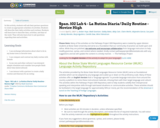
In this activity, students will ask their partner questions to create an appropriate schedule of activities. Students will describe their daily activities and routines. Students will learn how to describe time, activities, and days of the week. They will also learn how to ask questions regarding time and activities.
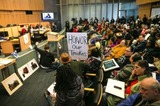
Local governments are the smallest and closest governments to us. They are usually the first place we turn when we need help. This is the teacher guide companion to The State We're In: Washington (Grade 3-5 Edition) Chapter 6. The resource is designed to engage students with a launch activity, focused notes, and a focused inquiry.

How do we define Public Art? This course focuses on the production of projects for public places. Public Art is a concept that is in constant discussion and revision, as much as the evolution and transformation of public spaces and cities are. Monuments are repositories of memory and historical presences with the expectation of being permanent. Public interventions are created not to impose and be temporary, but as forms intended to activate discourse and discussion. Considering the concept of a museum as a public device and how they are searching for new ways of avoiding generic identities, we will deal with the concept of the personal imaginary museum. It should be considered as a point of departure to propose a personal individual construction based on the concept of defining a personal imaginary museum - concept, program, collection, events, architecture, public diffusion, etc.